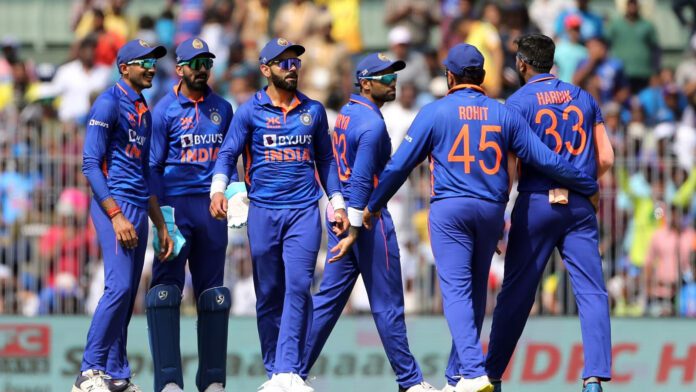In a momentous turn of events, cricket, often considered a sport confined to a select few nations, took significant strides towards becoming a truly global spectacle. Both these pivotal developments unfolded in India, the undeniable driving force behind the game’s popularity and influence. This article explores the recent advancements in cricket, particularly its inclusion in the Los Angeles 2028 Olympics, and examines how this move holds the promise of transforming the sport’s landscape, providing smaller nations with a unique opportunity to shine on the international stage.
I. India’s Dominance: Shaping Cricket’s Global Narrative
In the heart of New Delhi on October 15, Afghanistan achieved a historic feat by defeating defending champions England at the Cricket World Cup, marking a pivotal moment for the sport. The very next day, in Mumbai, the International Olympic Committee (IOC) announced cricket’s inclusion in the 2028 Olympic Games in Los Angeles. A significant push for this inclusion came from cricketing powerhouse India, leveraging its passion and financial clout in the cricketing world.
A. India’s Influence on the Global Stage
India, with its cricket-crazy population of 1.4 billion, plays a central role in shaping the narrative of cricket worldwide. The Indian Premier League (IPL), a T20 competition that began in 2008, stands as one of the most lucrative sporting events globally, attracting top players and a massive viewership. The country’s influence is pivotal, not just in terms of on-field prowess but also financially, with broadcast rights and sponsorship deals contributing substantially to the revenue of sporting organizations like the IOC.
B. Financial Implications for the IOC
The IOC, heavily reliant on broadcast rights and sponsorship deals for revenue, recognizes India as a lucrative market. With cricket’s inclusion in the 2028 Olympics, the Los Angeles Games are poised to witness a surge in viewership and financial gains, with estimates suggesting broadcast rights from Asia alone could exceed $250 million. For the IOC, grappling with challenges posed by illegal streaming, this inclusion becomes a strategic move to secure significant financial backing.
II. Nurturing the Olympic Dream: India’s Shifting Perspective
While India’s cricket board had reservations in the past about cricket as an Olympic sport, concerns over player workload and potential disruptions to existing tournaments have evolved. With India expressing its bid to host the 2036 Olympics, attitudes have shifted. Prime Minister Narendra Modi, a vocal supporter of cricket, expressed delight at cricket’s inclusion in the 2028 Olympics, seeing it as a reflection of the sport’s rising global popularity.
III. Smaller Nations’ Aspirations: A Commercial Game Changer
Smaller cricketing nations, often overshadowed by the dominance of established powers, see the inclusion of cricket in the Los Angeles 2028 Olympics as a potential game changer. With only six spots available for both men and women, securing a place may initially favor the traditional powerhouses. However, these nations anticipate significant benefits in terms of state funding, private investment, and enhanced infrastructure.
A. Afghanistan’s Triumph and Emerging Opportunities
Afghanistan’s recent triumph over England serves as a testament to the potential of smaller nations when provided with more opportunities. Shafiq Stanikzai, former CEO of the Afghan Cricket Board, emphasizes the need for increased opportunities against major teams, highlighting the positive correlation between exposure and performance.
B. Commercial and Financial Windfalls for Smaller Nations
Smaller cricketing nations foresee commercial and financial windfalls resulting from Olympic inclusion. The spotlight on the global stage brings opportunities for new broadcasting contracts, sponsors, and an influx of fans and investors. This influx of resources is expected to uplift grassroots development, coaching, and facilities, leveling the playing field for these nations.
IV. Spreading Cricket’s Wings: Global Impact Beyond Traditional Strongholds
The increased profile and revenues generated by cricket’s Olympic inclusion have the potential to propel the game into new territories. While only six nations might secure spots initially, the shorter formats of the game, particularly T20 cricket, can serve as an entry point for broader global participation.
A. Impact on Major Cricketing Outposts
Countries like Brazil, traditionally passionate about football, see cricket’s Olympic inclusion as an avenue for development, particularly in the female form of the game. Brazil’s women’s national team captain, Roberta Moretti Avery, anticipates increased accessibility and funding, both essential for the growth of cricket in the country.
B. Cricket’s Emerging Presence in the United States and China
In the United States, the first Major League Cricket season in July showcased the growing interest in the sport, driven significantly by the Indian diaspora. With Los Angeles hosting the 2028 Olympics, cricket’s visibility is expected to rise, potentially catapulting the game to new heights.
In China, a small but passionate cricket community awaits the benefits of state funding following the sport’s Olympic inclusion. This marks a potential turning point for cricket in the region and sets the stage for similar transformations in other nations.
V. Cricket’s Global Challenge: Turning Theory into Reality
With the opportunity to participate in the Olympics, cricket now faces the challenge of transforming theoretical prospects into tangible global growth. Simon Chadwick, a professor of political economy and sport, emphasizes that cricket must stimulate participation, draw audiences, attract partners, and sustain its commercial performance.
A. T20 Format as a Catalyst for Global Appeal
The success of the T20 format, characterized by its short and engaging contests, demonstrates cricket’s adaptability to modern demands. This format aligns well with the dynamics of events like the Olympics and holds appeal for broadcasters, potentially broadening cricket’s audience base.
B. Pressure and Opportunity for Cricket’s Global Evolution
Cricket’s inclusion in the Olympics signifies not just an opportunity for growth but a challenge to improve and evolve. The sport must navigate the complexities of global appeal, engagement, and commercial viability, ensuring that it becomes a truly global phenomenon.
VI. Conclusion: A Pivotal Moment for Cricket’s Future
As cricket prepares to take center stage at the 2028 Olympics, the journey from being a sport entrenched in tradition to a global spectacle is set to unfold. India’s instrumental role, coupled with the aspirations of smaller nations, marks a pivotal moment for cricket’s future. The Olympic platform provides an opportunity for the sport to transcend boundaries, engage new audiences, and establish itself as a truly global phenomenon. The challenge now lies in cricket’s ability to seize this moment, showcase its universal appeal, and lay the groundwork for sustained growth on the world stage.










